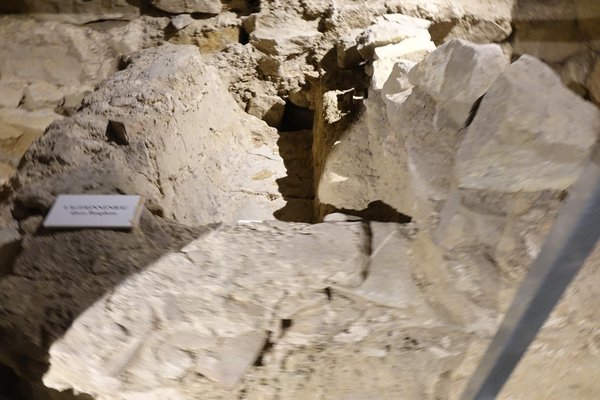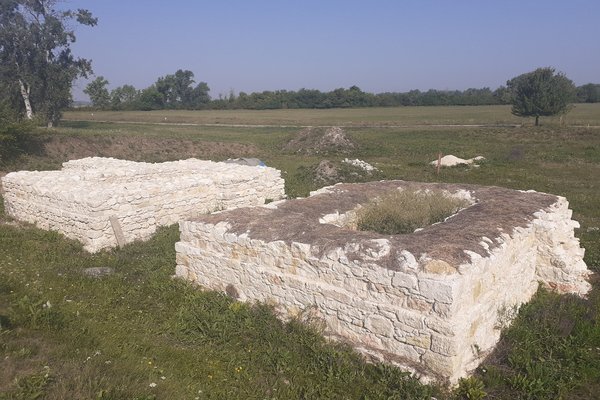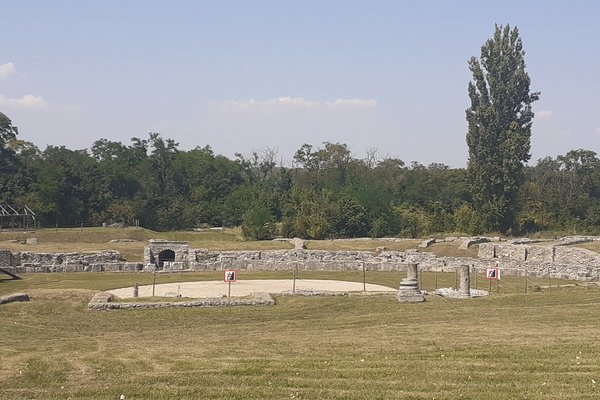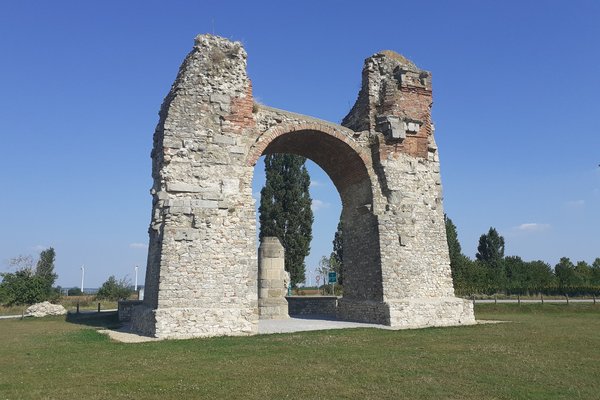Austria, Germany, Slovakia
Danube Limes
Frontiers of the Roman Empire – The Danube Limes (Western Segment) comprises the remains of the Roman border along the Danube River.
This 600km stretch of military installations was linked by a military road parallel to the river. The Pannonian fleet patrolled the river. A series of legionary fortresses, with thousands of soldiers each, formed its backbone. Civilian towns developed around them, and their Roman citizens introduced Roman culture (such as baths, shrines and an amphitheatre) to their surroundings.
Community Perspective: among its 75 locations, the most accessible ones are Vindobona in the center of Vienna and Porta Praetoria in Regensburg. Hubert provides a comprehensive overview of locations with visible remains in Germany, Austria and Slovakia.
Site Info
Official Information
- Full Name
- Frontiers of the Roman Empire – The Danube Limes (Western Segment) (ID: 1608)
- Status
-
Inscribed 2021
Site history
History of Danube Limes
- 2021: Revision
- Hungarian locations not inscribed after withdrawal by the State Party. This meant a reduction from 175 to 77 locations.
- 2021: Inscribed
- Inscribed
- 2019: Advisory Body overruled
- From Inscribe to Refer due to late withdrawal of Hungarian component parts
- 2019: Referred
- 2015: Revision
- Includes a reduced version of Old Town of Passau (1984)
- Type
- Cultural
- Criteria
- ii
- iii
- iv
Links
- UNESCO
- whc.unesco.org
- Official
-
- carnuntum.at — Roman City of Carnuntum
- Related
-
- donau-limes.at — Museums at the Danube Limes in Austria
All Links
UNESCO.org
- whc.unesco.org — whc.unesco.org/
Official Website
- carnuntum.at — Roman City of Carnuntum
Related Resources
- donau-limes.at — Museums at the Danube Limes in Austria
Community Information
- Community Category
- Archaeological site: Ancient Rome
- Secular structure: Military and Fortifications
Travel Information
Serial Transnational Sites
Exact locations inscribed twice (or more)
Recent Connections
-
European Heritage Label
Archaeological Park Carnuntum
-
Augustinian Order
(ID No 29) Klosterneuburg – Kastell un… -
Named after a River
Danube
Connections of Danube Limes
- Individual People
-
-
Charlemagne
Linz (ID No 13a/b): In 791 Charlemagne and his army passed Linz on a campaign against the Avars. In 799, the Emperor gave St. Martin's Church and its castrum to his brother-in-law Gerold as a fief.See de.wikipedia.org
-
Female Archaeologists
Christine Schwanzar – Schwanzar carried out emergency excavations for the Vicus at Schlögen in 1984 (ID No 11a) and for the Burgus at Hirschleitengraben (ID No 12).See de.wikipedia.org
-
Emperor Trajan
Bad Gögging (ID No 1): Emperor Trajan visited the area around 110 and had a thermal bath built for the garrison. Imprints on the bricks indicate that the bath was financed from both state and private assets of the emperor and was therefore of great importance.See de.wikipedia.org
-
- Geography
-
-
Danube
-
Linear inscriptions
"(...) the fortifications consisted of a continuous chain of military installations almost all along the southern banks of the river. The backbone of the defence system was a string of legionary fortresses". (Brief synthesis)See whc.unesco.org
-
Located in a Capital City
A component (Vindobona) lies in Vienna, capital of Austria -
Contiguous National Sites
In Germany, with "Frontiers of the Roman Empire": "The Frontiers of the Roman Empire – The Danube Limes started at Bad Gögging (...). At Eining it was connected with the Upper German‐Raetian Limes in the existing WHS "Frontier of the Roman Empire"." (Nomination file, p. 54)
-
- History
-
-
The Tetrarchy
Carnuntum (ID No 31): The political conflicts between his successors after his abdication prompted Diocletian to convene a meeting of all disputants in Carnuntum in 308 in order to settle the conflicts peacefully and revive the tetrarchy. In this historically significant meeting, the Augusti Diocletian, Galerius, Licinius and Maximinus Daia succeeded in placing the distribution of power in the Roman Empire on a new stable basis (so-called fourth tetrarchy).See de.wikipedia.org
-
Historical Food Remains
Passau Boiotro – Kastell (ID No 9b): In 1975 and 1977 charred plant remains were found in a layer of clay from the Horreums, which could be identified as grains of wheat, rye, barley and millet.See de.wikipedia.org
-
Buried treasures
Kastell Kumpfmühl (ID No 5): In 1989, during construction work in the west of the former Kumpfmühl fort, a deposit was discovered that turned out to be the largest coin find in southern Germany. Apart from coins, the hoard also comprised gold and silver jewelry.See de.wikipedia.org
-
Habsburgs (Austrian)
The 18th century "saw also the first measures towards a preservation of the remains of ancient buildings, like a decree of Maria Theresia (1740–1780) about preservation and publication of archaeological results, and a stipulation of Franz I concerning the Heidentor at Carnuntum (ID No 31), which needed protection from being dismantled." (Nomination file, p. 102) -
Limes
-
Ancient Roman colonies
Carnuntum (ID No 31): At the end of the 2nd century, the Upper Pannonian governor Septimius Severus was proclaimed emperor there by the Danubian legions and the civilian city was subsequently elevated to the rank of a colony.See de.wikipedia.org
-
Mentioned by Pliny the Elder
Carnuntum (ID No 31): BOOK XXXVII. THE NATURAL HISTORY OF PRECIOUS STONES. Chapter 11: "From Carnuntum in Pannonia, to the coasts of Germany from which the amber is brought, is a distance of about six hundred miles, a fact which has been only very recently ascertained (...)" -
Assassinations
Carnuntum (ID No 31): In 260, during the reign of Gallienus (253-268), the Carnuntine troops proclaimed the governor of Pannonia superior, Regalianus, as counter-emperor; however, he was not recognised by the Senate in Rome. His influence also never grew beyond the limes strip between Carnuntum and Brigetio. During his short reign he had coins minted with his image and that of his wife Sulpicia Dryantilla, some of which were found in Carnuntum. Only six months later, both were murdered by their own soldiers.See de.wikipedia.org
-
- Architecture
-
-
Spolia
"Certainly the first post Roman construction phase led to a considerable number of discoveries of inscriptions and building stones as can be deducted from their frequent use as spolia in Romanesque churches and buildings, sometimes in prominent visible positions and usually with a new Christian meaning." (Nomination file, p. 101) In the church of St. Martin in Linz (ID No 13a) Roman spolia are visible in the interior and exterior walls. (Nomination file, p. 67) Component part 25d (Traismauer – Kastell Hufeisenturm), "the so called Reck Tower or Hungerturm belonging to the northern front of the fort consists of antique masonry, up to the second floor, which contains numerous spolia." (Nomination file, p. 74) -
Mosaic art
Carnuntum (ID No 31): In House IV in the garden of Petronell Castle archaeologists came across the only Roman floor mosaic from Carnuntum that had survived in situ. In the 21st century, the mosaic was removed, restored and embedded in a new support material. Finally, in 2013, to protect and present the mosaic, the surrounding residential architecture was reconstructed as a partial reconstruction using ancient building techniques up to the eaves. After completion of the construction work, the mosaic was moved back to its original location.See de.wikipedia.org
-
- Damaged
-
-
Destroyed or damaged by Earthquake
Carnuntum (ID No 31): In 350 Carnuntum was shaken by a severe earthquake, which caused considerable damage to the infrastructure and is archaeologically attested (especially in the Canabae) by destruction layers on the large public buildings. Presumably, a large part of the civilian population migrated due to this catastrophe and because of an incipient climate deterioration in the late 4th century.See de.wikipedia.org
-
Destroyed during invasion
"One of the most significant periods of crisis in the history of the (...) Danube Limes was the time of the Marcomannic Wars (166–180 AD). Many fortifications and especially the civilian hinterland (...) were attacked, raided or even destroyed several times by barbarian tribes. Destruction levels have been identified on many sites in the Danube Limes provinces." (Nomination text, p. 99-100) Enns-Lauriacum (ID 14) was destroyed several times by Germanic tribes (Juthungi, Alemanni) in the third century, but it was the passage of the Huns in the fifth century that meant the end of the settlement.See de.wikipedia.org
-
- World Heritage Process
-
-
Extensions on Tentative List
There are extensions to the Danube Limes on the Tentative Lists of Bulgaria, Croatia, Hungary, Romania and Serbia. -
Serial Transnational Sites
3 countries -
Exact locations inscribed twice (or more)
Several of the Danube Limes locations in Regensburg lie within its Old Town; 7 locations of the Danube Limes lie also within the Wachau Cultural Landscape; 5 locations of the Danube Limes also lie within the Historic Centre of Vienna -
Controversial at inscription
ICOMOS had advised inscription of this stretch, but Hungary withdrew its nomination on the eve of the WHC. Whether the remaining parts in Germany, Austria and Slovakia had OUV according to ICOMOS was hard to say. Inscription was eventually forced after a secret ballot, with an adjusted nomination expected to be submitted in 2022.
-
Reconstruction regarded as unsatisfactory
"The most extensive reconstruction is at Carnuntum, where work is still in progress and, although reversible, is in places conjectural. At Iža (Kelemantia) parts of the fort have been rebuilt in a way that is not readily distinguishable from original material. (...) Large-scale conjectural reconstruction on top of original fabric needs to be avoided." (Brief synthesis)See whc.unesco.org
-
- Religion and Belief
-
-
Legends and Folk Myths
Carnuntum (ID No 31): The legend of the Roman treasure at the HeidentorSee de.wikipedia.org
-
Mithraism
Mithraeums were found in several locations, such as Künzing and Linz. The Mithraeum in Pöchlarn (ID No 18d) "is the only one preserved on the northern Danube limes and is directly connected with the military units garrisoned here." (Nomination file, p. 72) Several Mithraeums were discovered at Carnuntum (ID No 31). Mithraeum III, located in the western part of Petronell, was probably built in the late 2nd century and was one of the largest sacred buildings in Carnuntum.See de.wikipedia.org
-
Benedictines
"Although Roman ruins at Mautern were already known in the 11th century, the archaeological explorations were pursued only from the 19th century onwards, whereby especially the priests of the nearby Benedictine monastery of Göttweig made significant contributions." (Nomination file, p. 114) -
Augustinian Order
(ID No 29) Klosterneuburg – Kastell und Vicus - "A large part of the fort is hidden underneath the abbey of the Augustinian canons, which was founded in the 12th century, and is thus not visible. A few areas have been examined archeologically (...) and are today on display. The buildings of the fort below the abbey courtyards and the surrounding open areas have never been examined, while the historic buildings of the abbey also integrate substantial ancient structure." (Nomination file, p. 404) -
Hercules
Carnuntum (ID No 31): The heated camp sanctuary (sacellum) was located exactly in the central axis of the basilica. The most famous ancient stone sculptures from Carnuntum were found between the hypocaust pillars. To the west and east of the sacellum, the excavators were able to uncover two more rooms. The eastern one contained the statue of Hercules, which had probably been made in Virunum.See de.wikipedia.org
-
- Human Activity
-
-
Amber
Carnuntum (ID No 31) - The "area around Carnuntum became a hub for the connection between Northern and Southern Europe. This was due to the situation on the northern border of the Roman Empire and at the crossroad of the Limes road with an inner European long‐distance trade route, the so‐called Amber Road, which was at the same time the most important military‐strategic point for the Roman military to enter Germania magna. (Nomination file, p. 159) "In Roman times, Carnuntum had a history as a major trading centre for amber, brought from the north to traders who sold it in Italy; the main arm of the Amber Road crossed the Danube at Carnuntum."See en.wikipedia.org
-
Human Migration
"The 77 component sites (...) offer a clear understanding of the way military strategies evolved over time to counter threats considered by the Romans emanating from sustained large scale migrations in the later years of the Roman Empire (...)." (Brief synthesis)See whc.unesco.org
-
Ongoing Archaeological digs
Enns (ID No 14a-g): The Roman roots of Enns have been known since the Middle Ages. However, systematic and scientifically supervised excavations only began in the early 20th century and continue to this day.See de.wikipedia.org
-
Salt
Tulln – Kastell Hufeisenturm (ID No 27a): "Component part 27a is a late Roman horseshoe tower of the western front, which is preserved to the rooftop, whose excellent preservation is due to the Medieval re‐use as a stacking area for salt in the Danube region of Tulln." (Nomination file, p. 76) + Traismauer (ID No 25a-e): A trade route (iron and salt) approaching from the Mur valley in Styria met the Danube at Traismauer, crossed it and joined two old long-distance routes on the north bank, the so-called Manhartsberglinie and the Kamptalweg.See de.wikipedia.org
-
River Ports
Many of the forts along the Danube had river ports for the Roman fleet. Enns (ID No 14) had a "port of the Danube flotilla". In Vienna (Vindobona, ID No 30), there "has been evidence of a port from Late Antiquity, directly towards the north of the fortress. As early as the Roman Imperial Period, a naval base in Vindobona for parts of the classis Pannonica has to be assumed, due to the strategically important position at the Danube." (Nomination file, p. 78, 156) In the 4th century, the headquarters of the commander of the Danube fleet (Classis Histrica) was moved from Carnuntum to Vindobona.See de.wikipedia.org
-
Irrigation and drainage
Wien (ID No 30): "The Romans provided their cities, including Vindobona, with clean potable water through an elaborate systems of Roman aqueducts, canals, and large subterranean pipes. Excavations have revealed that Vindobona received its supply through a 17 km long water pipeline. (...) Waste from the Roman camp was transported through an elaborate subterranean sewerage system that was planned from the beginning. The sewers were lined with brick walls and plates and ran beneath the main roads."See en.wikipedia.org
-
- Constructions
-
-
Granaries
Passau Altstadt – Kastell (ID No9a): "(...) the excavations revealed well preserved structural remains of a granary that was part of the Late Roman fort. The walls of this granary are preserved up to a height of 1.3 m and have 1.5 m thick foundations." (Nomination file, p. 65) + Zeiselmauer – Kastell Kastentor (ID 28d): The excellent state of preservation of the complex is explained by its later use as a granary (tithe barn) by the Bishopric of Passau.See de.wikipedia.org
-
Aqueduct
Carnuntum (ID No 31): "In the western slope of the Pfaffenberg, an aqueduct can be closed due to an array of columns." (Nomination file, p. 78) -
Tumuli
Carnuntum (ID No 31): "cemeteries along the ancient radial roads, whereby elaborate tomb architecture such as funeral altars, pillar monuments or tomb chapels as well as tumulus tombs were found" (Nomination file, p. 79) -
Protective Shelters
Several components are protected by shelters, e.g. the well preserved walls of the burgus of Passau Haibach (ID No 9c), Kleinkastell Oberranna (ID No 10), the bath house in Schlögen (ID No 11a) and the porta principalis dextra of the fort in Tulln (ID No 27b). (Nomination file, p. 62, 66, 76) -
Cemeteries
There are cemeteries in several components, e.g. Regensburg, Linz, Enns, Mautern, Zwentendorf, Tulln, Klosterneuburg, Vienna, Carnuntum. These can be burial grounds or grave sites on both sides of the arterial roads, as was generally the case in Roman times. In Carnuntum (ID No 31), there are "cemeteries along the ancient radial roads, whereby elaborate tomb architecture such as funeral altars, pillar monuments or tomb chapels as well as tumulus tombs were found". (Nomination file, p. 79) "One of the more important ones is the one in Regensburg (ID No 5 & 6), which is the largest Roman cemetery in Germany."See de.wikipedia.org
-
Baths
Bad Gögging (ID No 1): "Substantial remains of the spa baths of legio III Italica were discovered here in the course of several excavation campaigns carried out between 1959 and 2007. The extensive building covered an area of at least 50 m by 36 m. It was formed by at least four building units, which housed numerous rooms with hypocaust heating, a steam room, several cold water pools and a 11 m by 8 m large central water basin with four to five hip‐baths attached to its north‐eastern wall." (Nomination file, p. 61) -
Prison
Carnuntum (ID No 31): In one of the buildings, a consecration altar was found that had been donated by the prison administrator Caius Pupilius Censorinus. The building was therefore interpreted by the excavators as a prison (carcer castrorum).See de.wikipedia.org
-
Triumphal Arches
Carnuntum (ID No 31): Among the last major building projects in the civilian city was a triumphal arch of the Emperor Constantius II southwest of the settlement area, the remains of which are now known as the Heidentor.See de.wikipedia.org
-
Frontier walls
The many defensive walls of the military forts and around military and civil settlements are a testimony of the protection these places needed at the frontier of the Roman Empire against "the barbarians". -
Hospitals
Carnuntum (ID No 31): The barracks, the central buildings principia (staff building), praetorium (accommodation for the legionary legate), the valetudinarium (camp hospital), three of the six tribune houses (officers' accommodation) and three larger farm buildings in the eastern half of the camp were almost completely excavated.See de.wikipedia.org
-
Roman amphitheatres
A wooden amphitheatre was found in Künzing (ID No 8). In Carnuntum (ID No 31), an "amphitheater preserved in the area which was built in the 70ies of the 1st century is (...) part of the cannabae". "The amphitheater of the civilian city is found in the southern part of the city, and has been reconstructed several times after it was built in 2nd century AD." (Nomination file, p. 65, 78-79) Amphitheatre I in Carnuntum served primarily as a weapons training ground for the legionaries. However, gladiator fights (munera) and show hunts (venationes) also took place there, probably also games arranged especially for the troops.See de.wikipedia.org
-
Horse Stables
Several forts along the Danube had garrisons with equestrian units. These forts therefore had horse stables, like in Zeiselmauer (ID 28a-d). The auxiliary fort in Carnuntum (ID No 31) was an equestrian camp. Remnants of horse stables have been identified in several of the construction phases.See de.wikipedia.org
-
Cisterns
Carnuntum (ID No 31): The camp was supplied with fresh water via running wells, cisterns and draw wells located along the main roads. The tribune houses each had their own wells, up to 6 m deep. Between two of the officers' houses, one came across a slightly sloping brick concrete pavement. Along its longitudinal axis, three cisterns with bevelled edges collected rainwater flowing down from the roofs.See de.wikipedia.org
-
- WHS on Other Lists
-
-
European Heritage Label
Archaeological Park Carnuntum
-
- Timeline
-
-
Built in the 1st century
First continuously defined in the Flavian dynasty (69-96 CE) (AB ev)
-
- WHS Hotspots
- Science and Technology
-
-
Archaeological potential
"The nominated component parts include not only the Roman architectural monuments which are preserved above the surface, but also archaeologically not yet examined and therefore fully undisturbed monuments underground." (Nomination file, p. 237) Enns – Gräberstraße (ID No 14a): "(...) graves and burial structures are clearly visible in the survey images. Road and graves are preserved under the earth's surface in their substance. The so far intact area of the cemetery is a zone with a particularly high research potential for Roman burial customs of Lauriacum." (Nomination file, p. 68) -
Early Archaeology
In multiple locations, excavations were conducted before the 20th century, e.g. Regensburg (2nd half of the 19th century), Künzing (1897-8), Schlögen (1838-40), Enns (mid 19th century), Carnuntum (from 1885), Bratislava-Rusovce (1888-91). (Nomination file, p. 106-108, 111, 117) -
Experimental Archaeology
Carnuntum: "Reconstructions have been erected using experimental archaeology. Building work was able to be carried out partly with original Roman stonework and with reconstructed Roman tools using ancient building technology and craft skills. All technical facilities in the buildings are fully functioning."See www.carnuntum.at
-
Recently discovered
Several components were discovered after 1970, e.g. Weltenburg‐Am Galget – Kleinkastell (ID No 3) in 1979 and the amphitheater in Künzing (ID No 8) in 2003-4. (Nomination file, p. 105, 108)
-
- WHS Names
-
-
Named after a River
Danube
-
News
No news.
Recent Visitors
Visitors of Danube Limes
- AC
- Adrian
- Adrian Turtschi
- Afshin Iranpour
- AK
- Alberto Rodriguez Gutierrez
- Alexander Barabanov
- Alexander Lehmann
- Alex Baranda
- Ammon Watkins
- Ana Lozano
- AndreaTLV
- Anne
- Antonio J.
- Argo
- Ask Gudmundsen
- Aspasia
- Astraftis
- a.thum
- Atila Ege
- awestix
- AYB
- BaziFettehenne
- Bernard Joseph Esposo Guerrero
- Bill Maurmann
- Bin
- BobSmithseestheworld
- Boj
- Bram de Bruin
- Brendan Carroll
- Bropyk
- brornt
- Can SARICA
- Carlo Sarion
- Carlos Sotelo
- Caspar
- Cezar Grozavu
- Chantal den Haan
- chenboada
- chenqtao
- Cheryl
- ChrisDorn
- Christian Wagner
- christof
- Christoph
- Christravelblog
- ClaraHH
- Clyde
- Csaba Nováczky
- CugelVance
- cutecid
- Damientournay
- Daniela Hohmann
- Daniel Chazad
- Daniel Gabi
- Danny L
- David Aaronson
- David Berlanda
- DavidS
- debatecoach
- Dimitar Krastev
- Don Irwin
- DonQuijote
- Dwight Zehuan Xiao
- Elia Vettorato
- Elisabeth Fransisca Situmorang
- Els Slots
- Emili Xaus
- erdsaumnaht
- Eric Lurio
- Erik G
- Erik Jelinek
- Errol Neo
- Eva Kisgyorgy
- Evgenii
- Federico P.
- Feldhase
- FK
- Fmaiolo@yahoo.com
- FrankW
- Frederik Dawson
- FS
- Gabor
- gautamiyer23
- George Gdanski
- GeorgeIng61
- GerhardM
- Gernot
- Hadrianus
- HaraldOest
- Harald T.
- Harry Mitsidis
- Hasco
- henrik_hannfors
- heywhatever2
- hszaby
- Hubert
- Hurrvinek
- Ian Cade
- Ivan
- Ivan Rucek
- Jacob Choi
- Jakob F.
- Jakubmarin
- James Bowyer
- James F
- Jana and Matt
- Janina Lehmann
- Jan-Willem
- Jan Zimmermann
- Jarek Pokrzywnicki
- Jasam
- Javier Coro
- Jawnbeary
- Jay T
- Jean Lecaillon
- Jens
- Jesse S 2010
- Jezza
- J_neveryes
- JobStopar
- Joel on the Road
- Johan
- Jonas Hagung
- Jonas Kremer
- jonathanfr
- jonstst
- JoStof
- Joyce van Soest
- jxrocky
- KarenBMoore
- Karito Vies
- Kasper
- Kbecq
- Ken DJ
- Kerékgyártó
- Kjlauer
- Klaus Freisinger
- Knut
- Krzysztof B
- Kurt Lauer
- La Concy
- lichia
- Linz
- Lisu Marian
- ljowers
- Loic Pedras
- Luboang
- Lucio
- Ludvan
- Luis Filipe Gaspar
- Lukasz Palczewski
- Maciej Gil
- Martina Rúčková
- Marton Kemeny
- Matejicek
- Matthewsharris
- MatusBeber
- MaxHeAnouBen
- MaYumin
- MC
- MH
- michaelsballard
- Mikko
- Mikko Syrjä
- Miloš Tašković
- Mohboh
- MoPython
- Mstrebl1990
- nan
- Nasebaer
- NH1984
- Nick M
- Nihal Ege
- PabloNorte
- palka25
- Patrik
- Patrik_globe
- Paul Schofield
- Persian Globetrotter
- Peter Lööv
- Petteri
- Philipp Leu
- Philipp Peterer
- phillipmeng
- Pincze
- Porcho
- Pradip Tripathy
- puessergio
- Purrfect
- Rafał Kałczuga
- Ralf Regele
- Ralf Rotheimer
- Randi Thomsen
- ReallyDeepThoughts
- Reisedachs
- Remigiusz
- Riccardo Quaranta
- Rick Ohm
- RobRos
- Roger Ourset
- Roman Bruehwiler
- Roman Raab
- Rudegirl
- Sabrina Liebehentschel
- Sandra!
- sbshipway
- Sebasfhb
- Sehnsuchtsbummler
- serghei.belous
- Shandos Cleaver
- Shijie ZHU
- shoaibmnagi
- SirLoydd
- Slavi
- sncjob
- Solivagant
- Sorel Americo
- Stanislaw Warwas
- stephanvermeulen
- Stijn
- Svein Elias
- SymonMajewski
- Szucs Tamas
- takanenohana
- Tamara Ratz
- Taotao Chen
- Tarquinio_Superbo
- Tcchang0825
- Tetena
- Tevity
- Thomas Buechler
- Thomas Harold Watson
- Thorben
- Tim Allen
- Timothy C Easton
- Tonisan
- tony0001
- Tony H.
- triath
- Tschibi
- Tsunami
- ValiaVeweth
- Vanessa Buechler
- VB73
- Velvetlapis
- Viaje al Patrimonio
- VLabhard
- voyager
- WalGra
- Wojciech Fedoruk
- Xander Huang
- Xiquinho Silva
- YaroMir
- Yevhen Ivanovych
- Zach
- Złoty Tłok Czesław
- Zoë Sheng
- Zos M
Community Reviews
Show full reviews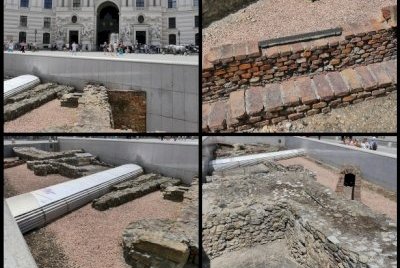
I have visited this WHS on multiple occasions before inscription in 2013 and 2015 in Regensburg, Germany, and in 2015, 2017, 2020 in Vienna, Austria. I only had a short video of the archaeological remains of the Danube Limes in Michaelerplatz, Vienna so this time round in 2022 during a brief family reunion, I made it a point to revisit the square and take some photos for my collection.
Not that now I have spectacular photos, nor did I get much more insight by this conscious visit post-inscription. Best time to visit is around noon when the sun shines on the remains. There are a couple of information boards on both sides of the square and also on the floor near the closed off remains themselves. Small appropriately placed bronze plaques give you a better idea of what the foundations once were and their approximate date of construction. As of 2022, there still is no UNESCO WHS plaque for the Historic Centre of Vienna, nor is there one for the Danube Limes.
These kind of WHS detract from the overall value of the WH list and provide no real value added unfortunately. They are a mere tick to bolster capital cities' status or tourist centres as hotspots and are not worth visiting simply for their own merit (should they have any!).
Keep reading 0 comments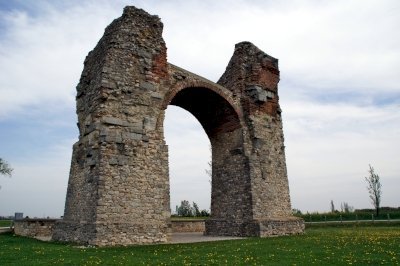
To sum it up right at the beginning: There is not much to see at the Danube Limes. Most of the remains are hidden under fields and meadows or have been overbuilt by later settlements and newly founded towns. There are hardly any larger visible structures. Often only some foundation walls are visible or the original remains are preserved as components of later buildings.On several trips in the last years, since the Danube Limes appeared on the tentative list in 2015, I have visited most of the locations with visible remains. The nomination files provide detailed descriptions of each site and what you can see there. For those who don't want to go through more than a thousand pages, I will summarise my visits in this review. I will focus on the most rewarding locations and those that can easily be combined with other visits because they are within the core zone of other World Heritage Sites (Regensburg, Vienna, Wachau) or close to them.
The numbering of the multiple locations is confusing: the Unesco website lists 77 locations with consecutive IDs. In the nomination documents, locations within the same buffer zone are grouped together and listed as sublocations (a, b, c...). I specified both IDs in brackets (ID Unesco website/ID nom file).
Germany
The Danube Limes WHS starts with the remains of a thermal baths in Bad Gögging (1/1), about 50 kilometres southwest of Regensburg. Only a small part of the baths has been excavated and can …
Keep reading 0 comments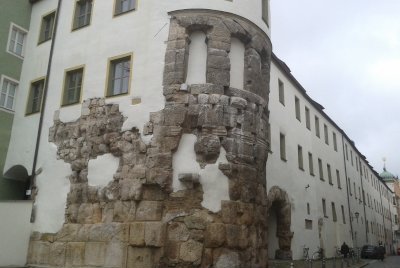
From the German locations included in this huge nomination, I have seen only remainings of CASTRA REGINA in Regensburg (already WHS by itself) as several parts of its fortification are still visible "in situ" (I have seen maybe two- or three-times during my occasional visits of Regensburg). The best known and at the same time the most spectacular part is PORTA PREATORIA (PHOTO), which is quite nice and impressive structure takeing into account how old this gate is. I had also oportunity to see the excavations below Niedermunster church located quite close to the gate, and parts of walls of late Roman barracks or residential villa are presented for organized tours in the underground of the church, but these are not very spectacular.
My opinion is that it does not deserve WHC status at all. Regensburg is already WHS and better preserved PORTA NIGRA in Trier has been already inscribed as well. Despite my skepticism towards this TWHS, I expect smooth after-referral inscription in 2020.
Keep reading 0 comments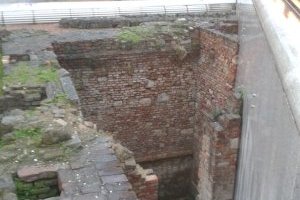
I saw excavated parts of VINDOBONA on Michaelerplatz in the very center of Vienna many times (PHOTO is from my last visit one gloomy day in November 2019). I am also pretty sure that I saw walls, ramparts and watchtowers dating to Roman times during my numerous visits of Wachau valley around Melk and Krems, but honestly I have no memmories on this particular point. Moreover, all the parts I saw (or potentially saw) are already included in the existing WHS Vienna and Wachau, and I would not be surprised if they are mentioned as justifications of OUV of these WHS.
Though the remainings the Roman outpost at Michaelerplatz are quite huge and nicely presented to everybody who is walking from Hofburg to Graben, I do not really understand the reason why this should be declared as WHS.
Some of us maybe remember why this extremely huge nomination was reffered during the WHC session in Azerbaijan in 2019... I gues it will be inscribed in 2020 anyway.
Keep reading 0 comments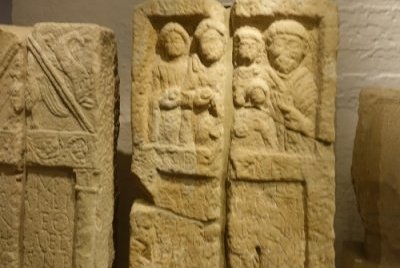
The Danube Limes was the Roman military border along the Danube. The Romans here used the river as a natural boundary: there was no boundary wall such as for example the Hadrian's Wall in northern England. This 'border' consisted of a series of defense towers, auxiliary forts and larger legionary fortresses.
The Danube Limes is nominated to become a WHS in 2019. It will be an additional site to the existing Frontiers of the Roman Empire WHS, not an extension of it. The nomination includes no fewer than 164 locations in Austria, Germany, Hungary and Slovakia. And for 2021 an extension into Bulgaria, Romania, Serbia and Croatia is already scheduled. The rationale behind this is explained as: "Unlike the Roman monuments already inscribed, the ... constructions are evidence from the edges of the Empires and reflect the adoption of Roman culture by its subject peoples."
From the sparse remains that are left of this border, I visited those in the Austrian town of Klosterneuburg. It lies half an hour drive from the airport of Vienna and thus was a nice ending of my WHS weekend in Czechia. Approaching in my rented Opel Corsa, my navigation app suddenly showed a 'ferry crossing'. Klosterneuburg lies on the 'other side' of the Danube and there is no bridge in the area. So I reluctantly took the third spot of four that the car ferry can transport - at least it gave me a feel for the width of the Danube again.
… Keep reading 0 comments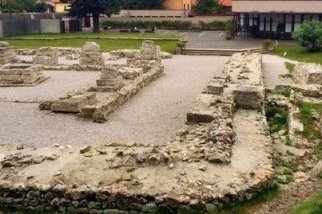
The Slovakian extension to the Roman Frontier Fortifications is minor but in my opinion highly important to the history of the Roman Empire. There are only two locations in Slovakia due to the Danube being the natural border between the Germanic and Roman forces. I went to the museum near Bratislava just across the river, far enough outside the city to actually not be Bratislava anymore but more importantly nowhere near bad traffic. The museum is called Ancient Gerulata Rusovce and features a small Roman military camp.
It has several layers of buildings from different time periods, most of them just presented by walls. The inside of the museum contains a lot of billboards for history fanatics and explains the region's fortification very well. The reason I found the camp important is that the Romans first did not cross the river due to logistic reasons but later on Emperor Antoninus no longer wanted to fight a war with the Germanic tribes and even had peace treaties.
After going through the inside for around 20 minutes you can still see the outside from a viewpoint but there is not much to see that you couldn't glance at during your walk to the museum. The museum doesn't cost much, parking should be easily found nearby (although I'm not sure why they can't add a few spaces for the museum just outside the gate), and for anyone near Bratislava I would recommend going here. I also regret driving by Iza, the …
Keep reading 0 comments
